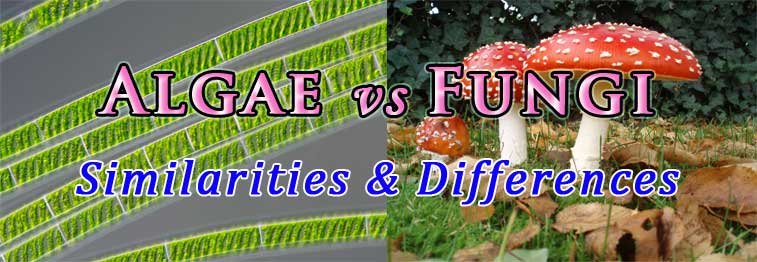Algae vs Fungi
Algae and fungi are thallophytic cryptogams of plant Kingdom. Both algae and fungi share many common characteristics and thus they are treated in the same division Thallophyta of Cryptogams according to Eichler’s Classification. Even though they are in same class, thallophyta, they also show some distinct differences particularly in their mode of nutrition, physiology and reproduction. This post describes what are the Similarities and Difference between Algae and Fungi.
Similarities between Algae and Fungi
Ø Both algae and fungi are thallophytes (plant body not differentiated into root, stem and leaves)
Ø Both algae and fungi are placed together in the division thallophyta of cryptogams
Ø With the exception of blue green algae, majority of algae and fungi are eukaryotic

Ø Vascular tissue system is absent in both groups
Ø Both algae and fungi processes cell wall made of polysaccharides, chemical nature of cell wall varies in algae and fungi
Ø Symbiotic members are present in both groups (algae with animals, fungi with roots of higher plants, between algae and fungi as in lichens)
Ø Both groups can reproduce by vegetative reproduction by fragmentation
Ø Both algae and fungi can reproduce asexually by the production of various motile and non-motile spores
Ø Sex organs are naked in both groups, no protective covering for sex organs in both groups
Difference between Algae and Fungi
Sl. No. Algae Fungi
1 Example: Oscillatoria (BGA), Oedogonium, Chara, Diatoms, Sargassum, Polysiphonia Examples: Pythium, Phytopthora, Rhizopus, Aspergillus, Puccinia, Agaricus (mushrooms)
2 Mostly aquatic Mostly terrestrial
3 Chlorophyll present Chlorophyll absent
4 Autotrophic nutrition Heterotropic nutrition
5 Light is necessary for the survival Light is not necessary for the survival
6 Few algae are prokaryotic (Blue Green Algae) Majority are eukaryotic All fungi are eukaryotic
7 Usually Green coloured Usually colourless (hyaline) sometimes bright coloured, never will be green
8 Plant body filamentous or parenchymatous Plant body filamentous or pseudo-parenchymatous
9 Cell wall composed of cellulose Cell wall composed of chitin
10 Cells usually uninucleate Cells usually bi-nucleate or multinucleate
11 Reserve food material is starch Reserve food material is glycogen
12 Spore are always endospores in algae (endospore = spores produced inside the sporangium) Spore are always endospores in algae (endospore = spores produced inside the sporangium)
13 Shows progressive complexity in sexual reproduction Shows progressive simplicity in sexual reproduction
14 Sexual reproduction is simple in lower forms of algae and it is complex in advanced forms Sexual reproduction is complex in lower forms of fungi and it is simple in advanced forms
15 Mitosis is usual type, nuclear membrane disorganize during mitosis Mitosis is special type called endo mitosis, nuclear membrane do not disorganize during mitosis
16 Parasitic members are very uncommon Parasitic members of very common
17 Zoospores, aplanospores, Chlamydospores etc. are important spores Conidiospores, zoospores and aplanospores are important spores
18 Sexual reproduction occurs by isogamy, anisogamy or oogamy Sexual reproduction occurs by isogamy, anisogamy, oogamy, gametangial contact, gametangial copulation, spermatization and somatic hybridization
19 During union of games, plasmogamy immediately follows karyogamy In higher fungi delayed karyogamy occurs
20 Dikaryotic phase is completely absent Distinct dikaryotic phase is present in some higher fungi like members of Ascomycetes and Basidiomycetes
21 Clamp connection and crozier formation are completely absent in algae Clamp connection and crozier formation are present in higher fungi for the establishment of dikaryotic phase
22 Para-sexual cycle is not reported in algae Para-sexual cycle is reported in many fungi
It’s useful for high school students
This is helpful i like it
Needs your notes